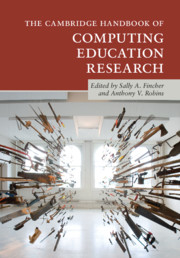Book contents
- The Cambridge Handbook of Computing Education Research
- The Cambridge Handbook of Computing Education Research
- Copyright page
- Dedication
- Contents
- Figures
- Tables
- Contributors
- Acknowledgments
- 0 An Important and Timely Field
- Part I Background
- Part II Foundations
- 4 A Study Design Process
- 5 Descriptive Statistics
- 6 Inferential Statistics
- 7 Qualitative Methods for Computing Education
- 8 Learning Sciences for Computing Education
- 9 Cognitive Sciences for Computing Education
- 10 Higher Education Pedagogy
- 11 Engineering Education Research
- Part III Topics
- Index
- References
4 - A Study Design Process
from Part II - Foundations
Published online by Cambridge University Press: 15 February 2019
- The Cambridge Handbook of Computing Education Research
- The Cambridge Handbook of Computing Education Research
- Copyright page
- Dedication
- Contents
- Figures
- Tables
- Contributors
- Acknowledgments
- 0 An Important and Timely Field
- Part I Background
- Part II Foundations
- 4 A Study Design Process
- 5 Descriptive Statistics
- 6 Inferential Statistics
- 7 Qualitative Methods for Computing Education
- 8 Learning Sciences for Computing Education
- 9 Cognitive Sciences for Computing Education
- 10 Higher Education Pedagogy
- 11 Engineering Education Research
- Part III Topics
- Index
- References
Summary
- Type
- Chapter
- Information
- The Cambridge Handbook of Computing Education Research , pp. 81 - 101Publisher: Cambridge University PressPrint publication year: 2019
References
- 2
- Cited by

